(All information courtesy of the instrument teams.)
![]() Previous IAU Circulars
Previous IAU Circulars
TITLE: GCN/FERMI NOTICE
NOTICE_DATE: Sat 14 Aug 10 03:50:24 UT
NOTICE_TYPE: Fermi-GBM Flight Position
RECORD_NUM: 44
TRIGGER_NUM: 303450610
GRB_RA: 25.100d {+01h 40m 24s} (J2000),
25.236d {+01h 40m 57s} (current),
24.462d {+01h 37m 51s} (1950)
GRB_DEC: -1.200d {-01d 11' 59"} (J2000),
-1.147d {-01d 08' 46"} (current),
-1.453d {-01d 27' 09"} (1950)
GRB_ERROR: 12.00 [deg radius, statistical plus systematic]
GRB_INTEN: 293 [cnts/sec]
DATA_SIGNIF: 13.20 [sigma]
INTEG_TIME: 1.024 [sec]
GRB_DATE: 15422 TJD; 226 DOY; 10/08/14
GRB_TIME: 13808.81 SOD {03:50:08.81} UT
GRB_PHI: 236.00 [deg]
GRB_THETA: 70.00 [deg]
DATA_TIME_SCALE: 1.0240 [sec]
HARD_RATIO: 0.21
LOC_ALGORITHM: 3 (version number of)
MOST_LIKELY: 97% GRB
2nd_MOST_LIKELY: 1% Generic Transient
DETECTORS: 0,0,0, 0,0,0, 0,1,1, 0,0,0, 0,0,
SUN_POSTN: 143.65d {+09h 34m 37s} +14.41d {+14d 24' 34"}
SUN_DIST: 117.76 [deg] Sun_angle= 7.9 [hr] (West of Sun)
MOON_POSTN: 194.37d {+12h 57m 29s} -11.71d {-11d 42' 24"}
MOON_DIST: 163.22 [deg]
MOON_ILLUM: 22 [%]
GAL_COORDS: 149.34,-61.54 [deg] galactic lon,lat of the burst (or transient)
ECL_COORDS: 22.81,-10.83 [deg] ecliptic lon,lat of the burst (or transient)
COMMENTS: Fermi-GBM Flight-calculated Coordinates.
COMMENTS: This trigger occurred at longitude,latitude = 49.68,21.45 [deg].
TITLE: GCN/FERMI NOTICE
NOTICE_DATE: Sat 14 Aug 10 03:50:33 UT
NOTICE_TYPE: Fermi-GBM Flight Position
RECORD_NUM: 58
TRIGGER_NUM: 303450610
GRB_RA: 19.083d {+01h 16m 20s} (J2000),
19.216d {+01h 16m 52s} (current),
18.459d {+01h 13m 50s} (1950)
GRB_DEC: -10.417d {-10d 24' 59"} (J2000),
-10.361d {-10d 21' 38"} (current),
-10.680d {-10d 40' 48"} (1950)
GRB_ERROR: 7.52 [deg radius, statistical plus systematic]
GRB_INTEN: 293 [cnts/sec]
DATA_SIGNIF: 24.70 [sigma]
INTEG_TIME: 4.096 [sec]
GRB_DATE: 15422 TJD; 226 DOY; 10/08/14
GRB_TIME: 13808.81 SOD {03:50:08.81} UT
GRB_PHI: 231.00 [deg]
GRB_THETA: 80.00 [deg]
DATA_TIME_SCALE: 4.0960 [sec]
HARD_RATIO: 0.35
LOC_ALGORITHM: 3 (version number of)
MOST_LIKELY: 96% GRB
2nd_MOST_LIKELY: 3% Generic Transient
DETECTORS: 0,0,0, 0,0,0, 0,1,1, 0,0,0, 0,0,
SUN_POSTN: 143.65d {+09h 34m 37s} +14.41d {+14d 24' 34"}
SUN_DIST: 125.70 [deg] Sun_angle= 8.3 [hr] (West of Sun)
MOON_POSTN: 194.37d {+12h 57m 30s} -11.71d {-11d 42' 26"}
MOON_DIST: 157.41 [deg]
MOON_ILLUM: 22 [%]
GAL_COORDS: 143.45,-72.29 [deg] galactic lon,lat of the burst (or transient)
ECL_COORDS: 13.50,-17.09 [deg] ecliptic lon,lat of the burst (or transient)
COMMENTS: Fermi-GBM Flight-calculated Coordinates.
COMMENTS: This trigger occurred at longitude,latitude = 49.68,21.45 [deg].
TITLE: GCN/FERMI NOTICE
NOTICE_DATE: Sat 14 Aug 10 03:50:47 UT
NOTICE_TYPE: Fermi-GBM Ground Position
RECORD_NUM: 69
TRIGGER_NUM: 303450610
GRB_RA: 20.170d {+01h 20m 41s} (J2000),
20.300d {+01h 21m 12s} (current),
19.560d {+01h 18m 14s} (1950)
GRB_DEC: -17.490d {-17d 29' 23"} (J2000),
-17.434d {-17d 26' 03"} (current),
-17.752d {-17d 45' 05"} (1950)
GRB_ERROR: 3.67 [deg radius, statistical only]
DATA_SIGNIF: 30.20 [sigma]
DATA_INTERVAL: 4.096 [sec]
GRB_DATE: 15422 TJD; 226 DOY; 10/08/14
GRB_TIME: 13808.81 SOD {03:50:08.81} UT
GRB_PHI: 233.00 [deg]
GRB_THETA: 87.00 [deg]
E_RANGE: 44.032 - 279.965 [keV]
LOC_ALGORITHM: 413 (Gnd S/W Version number)
SUN_POSTN: 143.65d {+09h 34m 37s} +14.41d {+14d 24' 33"}
SUN_DIST: 125.64 [deg] Sun_angle= 8.2 [hr] (West of Sun)
MOON_POSTN: 194.38d {+12h 57m 30s} -11.71d {-11d 42' 29"}
MOON_DIST: 150.28 [deg]
MOON_ILLUM: 22 [%]
GAL_COORDS: 159.45,-78.23 [deg] galactic lon,lat of the burst (or transient)
ECL_COORDS: 11.50,-23.99 [deg] ecliptic lon,lat of the burst (or transient)
COMMENTS: Fermi-GBM Ground-calculated Coordinates.
COMMENTS: This Notice was ground-generated -- not flight-generated.
TITLE: GCN/INTEGRAL NOTICE
NOTICE_DATE: Sat 14 Aug 10 03:51:05 UT
NOTICE_TYPE: INTEGRAL SPI ACS Trigger
TRIGGER_NUM: 6056, Sub_Num: 0
GRB_INTEN: 9.14 [sigma]
GRB_TIME: 13807.34 SOD {03:50:07.34} UT
GRB_DATE: 15422 TJD; 226 DOY; 10/08/14
COMMENTS: INTEGRAL SPI_ACS GRB Trigger.
COMMENTS:
COMMENTS: NOTE: This SPIACS event is temporally(1.0<100sec) coincident
+with the FERMI_GBM event (trignum=303450610).
COMMENTS:
COMMENTS: The SPIACS lightcurve can be found at:
COMMENTS:
+ftp://isdcarc.unige.ch/arc/FTP/ibas/spiacs/2010-08/2010-08-14T03-50-07.2289-02872-00007-0.lc
TITLE: GCN/SWIFT NOTICE
NOTICE_DATE: Sat 14 Aug 10 03:55:00 UT
NOTICE_TYPE: Swift-BAT GRB Position
TRIGGER_NUM: 431605, Seg_Num: 0
GRB_RA: 22.481d {+01h 29m 55s} (J2000),
22.609d {+01h 30m 26s} (current),
21.874d {+01h 27m 30s} (1950)
GRB_DEC: -17.986d {-17d 59' 07"} (J2000),
-17.931d {-17d 55' 51"} (current),
-18.243d {-18d 14' 35"} (1950)
GRB_ERROR: 3.00 [arcmin radius, statistical only]
GRB_INTEN: 7666 [cnts] Image_Peak=834 [image_cnts]
TRIGGER_DUR: 1.024 [sec]
TRIGGER_INDEX: 146 E_range: 25-100 keV
BKG_INTEN: 30306 [cnts]
BKG_TIME: 13793.92 SOD {03:49:53.92} UT
BKG_DUR: 8 [sec]
GRB_DATE: 15422 TJD; 226 DOY; 10/08/14
GRB_TIME: 13811.26 SOD {03:50:11.26} UT
GRB_PHI: -12.42 [deg]
GRB_THETA: 26.28 [deg]
SOLN_STATUS: 0x3
RATE_SIGNIF: 57.28 [sigma]
IMAGE_SIGNIF: 19.15 [sigma]
MERIT_PARAMS: +1 +0 +0 +0 +2 +6 +0 +0 +55 +0
SUN_POSTN: 143.66d {+09h 34m 38s} +14.41d {+14d 24' 30"}
SUN_DIST: 123.50 [deg] Sun_angle= 8.1 [hr] (West of Sun)
MOON_POSTN: 194.42d {+12h 57m 40s} -11.72d {-11d 43' 27"}
MOON_DIST: 149.26 [deg]
MOON_ILLUM: 22 [%]
GAL_COORDS: 169.07,-77.26 [deg] galactic lon,lat of the burst (or transient)
ECL_COORDS: 13.49,-25.34 [deg] ecliptic lon,lat of the burst (or transient)
COMMENTS: SWIFT-BAT GRB Coordinates.
COMMENTS: This Notice was delayed by more than 60 sec past the end of the trigger integration interval;
COMMENTS: probably due to it occurring during a Malindi downlink session.
COMMENTS: This is a rate trigger.
COMMENTS: A point_source was found.
COMMENTS: This does not match any source in the on-board catalog.
COMMENTS: This does not match any source in the ground catalog.
COMMENTS: This is a GRB.
COMMENTS: This trigger occurred at longitude,latitude = 14.76,-13.11 [deg].
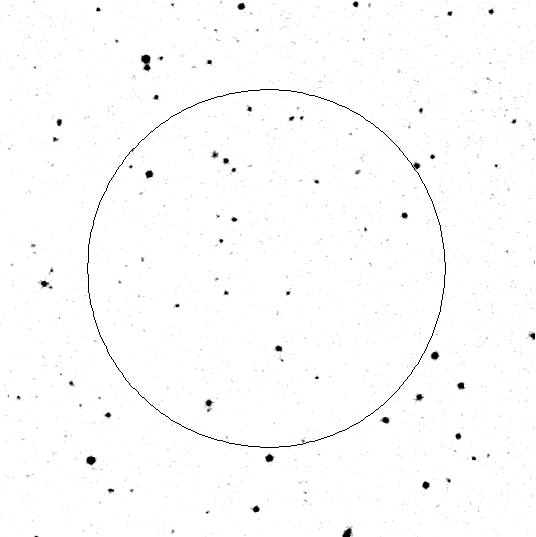
TITLE: GCN/SWIFT NOTICE
NOTICE_DATE: Sat 14 Aug 10 03:55:36 UT
NOTICE_TYPE: Swift-XRT Position
TRIGGER_NUM: 431605, Seg_Num: 0
GRB_RA: 22.4699d {+01h 29m 52.77s} (J2000),
22.5986d {+01h 30m 23.65s} (current),
21.8638d {+01h 27m 27.30s} (1950)
GRB_DEC: -17.9954d {-17d 59' 43.4"} (J2000),
-17.9408d {-17d 56' 26.9"} (current),
-18.2532d {-18d 15' 11.6"} (1950)
GRB_ERROR: 4.8 [arcsec radius, statistical plus systematic, 90% containment]
GRB_INTEN: 6.18e-09 [erg/cm2/sec]
GRB_SIGNIF: 12.24 [sigma]
IMG_START_DATE: 15422 TJD; 226 DOY; 10/08/14
IMG_START_TIME: 13898.61 SOD {03:51:38.61} UT, 87.4 [sec] since BAT Trigger Time
TAM[0-3]: 327.67 237.23 261.56 243.28
AMPLIFIER: 2
WAVEFORM: 134
SUN_POSTN: 143.66d {+09h 34m 38s} +14.41d {+14d 24' 30"}
SUN_DIST: 123.51 [deg] Sun_angle= 8.1 [hr] (West of Sun)
MOON_POSTN: 194.42d {+12h 57m 41s} -11.73d {-11d 43' 35"}
MOON_DIST: 149.25 [deg]
MOON_ILLUM: 22 [%]
GAL_COORDS: 169.06,-77.28 [deg] galactic lon,lat of the burst
ECL_COORDS: 13.48,-25.34 [deg] ecliptic lon,lat of the burst
COMMENTS: SWIFT-XRT Coordinates.
COMMENTS: The XRT position is 0.85 arcmin from the BAT position.
COMMENTS: The object found at this position is either a very bright burst or a cosmic ray hit.
COMMENTS: Examine the XRT Image to differentiate (CRs are much more compact); see examples at:
COMMENTS: http://www.swift.psu.edu/xrt/XRT_Postage_Stamp_Image_Photo_Gallery.htm .
TITLE: GCN/SWIFT NOTICE
NOTICE_DATE: Sat 14 Aug 10 03:55:46 UT
NOTICE_TYPE: Swift-XRT Image
TRIGGER_NUM: 431605, Seg_Num: 0
GRB_RA: 22.4699d {+01h 29m 52.7s} (J2000),
22.5986d {+01h 30m 23.6s} (current),
21.8638d {+01h 27m 27.3s} (1950)
GRB_DEC: -17.9954d {-17d 59' 43.4"} (J2000),
-17.9408d {-17d 56' 26.9"} (current),
-18.2532d {-18d 15' 11.6"} (1950)
GRB_ERROR: 4.7 [arcsec, radius, statistical plus systematic]
GRB_INTEN: 150 [cnts]
IMG_START_DATE: 15422 TJD; 226 DOY; 10/08/14
IMG_START_TIME: 13898.61 SOD {03:51:38.61} UT, 87.4 [sec] since BAT Trigger Time
CENTROID_X: 288.97, raw= 289 [pixels]
CENTROID_Y: 296.20, raw= 296 [pixels]
ROLL: 84.37 [deg]
GAIN: 4
MODE: 3, Long Image mode
WAVEFORM: 134
EXPO_TIME: 2.50 [sec]
GRB_POS_XRT_Y: -4.23
GRB_POS_XRT_Z: -31.41
IMAGE_URL: sw00431605000msxps_rw.img
SUN_POSTN: 143.66d {+09h 34m 38s} +14.41d {+14d 24' 30"}
SUN_DIST: 123.51 [deg] Sun_angle= 8.1 [hr] (West of Sun)
MOON_POSTN: 194.42d {+12h 57m 42s} -11.73d {-11d 43' 37"}
MOON_DIST: 149.25 [deg]
MOON_ILLUM: 22 [%]
GAL_COORDS: 169.06,-77.28 [deg] galactic lon,lat of the burst
ECL_COORDS: 13.48,-25.34 [deg] ecliptic lon,lat of the burst
COMMENTS: SWIFT-XRT Image.

TITLE: GCN/SWIFT NOTICE
NOTICE_DATE: Sat 14 Aug 10 03:56:22 UT
NOTICE_TYPE: Swift-BAT GRB Lightcurve
TRIGGER_NUM: 431605, Seg_Num: 0
GRB_RA: 22.481d {+01h 29m 55s} (J2000),
22.609d {+01h 30m 26s} (current),
21.874d {+01h 27m 30s} (1950)
GRB_DEC: -17.986d {-17d 59' 07"} (J2000),
-17.931d {-17d 55' 51"} (current),
-18.243d {-18d 14' 35"} (1950)
GRB_DATE: 15422 TJD; 226 DOY; 10/08/14
GRB_TIME: 13811.26 SOD {03:50:11.26} UT
TRIGGER_INDEX: 146
GRB_PHI: -12.42 [deg]
GRB_THETA: 26.28 [deg]
DELTA_TIME: 25.00 [sec]
TRIGGER_DUR: 1.024 [sec]
SOLN_STATUS: 0x3
RATE_SIGNIF: 57.28 [sigma]
IMAGE_SIGNIF: 19.15 [sigma]
LC_URL: sw00431605000msb.lc
SUN_POSTN: 143.66d {+09h 34m 38s} +14.41d {+14d 24' 29"}
SUN_DIST: 123.50 [deg] Sun_angle= 8.1 [hr] (West of Sun)
MOON_POSTN: 194.43d {+12h 57m 43s} -11.73d {-11d 43' 46"}
MOON_DIST: 149.26 [deg]
MOON_ILLUM: 22 [%]
GAL_COORDS: 169.07,-77.26 [deg] galactic lon,lat of the burst (or transient)
ECL_COORDS: 13.49,-25.34 [deg] ecliptic lon,lat of the burst (or transient)
COMMENTS: SWIFT-BAT GRB Lightcurve.
COMMENTS:
COMMENTS: The next comments were copied from the BAT_POS Notice:
COMMENTS: This is a rate trigger.
COMMENTS: A point_source was found.
COMMENTS: This does not match any source in the on-board catalog.
COMMENTS: This does not match any source in the ground catalog.
COMMENTS: This is a GRB.
COMMENTS: This trigger occurred at longitude,latitude = 14.76,-13.11 [deg].
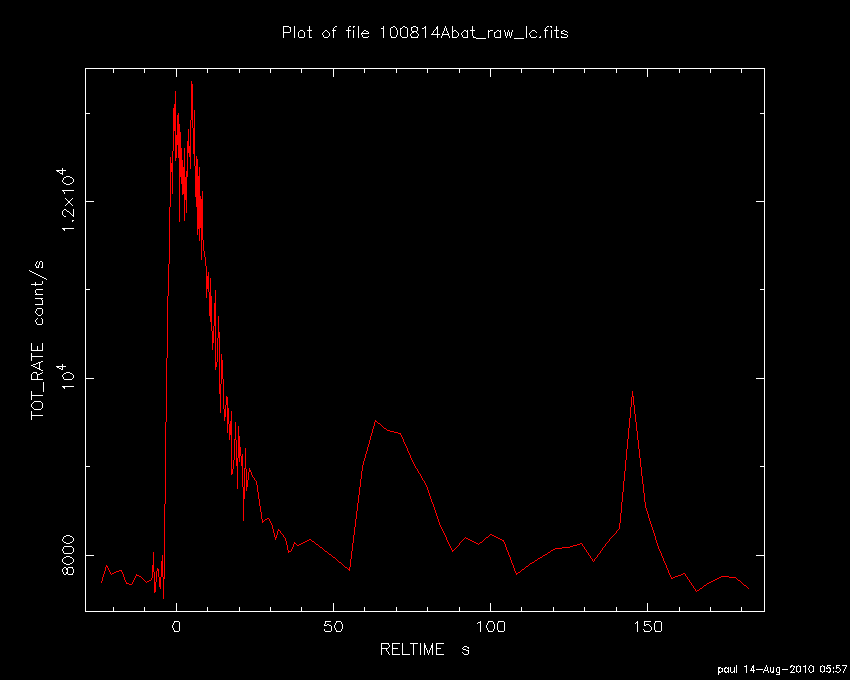
TITLE: GCN/SWIFT NOTICE
NOTICE_DATE: Sat 14 Aug 10 03:55:53 UT
NOTICE_TYPE: Swift-XRT Processed Image
TRIGGER_NUM: 431605, Seg_Num: 0
GRB_RA: 22.4699d {+01h 29m 52.7s} (J2000),
22.5986d {+01h 30m 23.6s} (current),
21.8638d {+01h 27m 27.3s} (1950)
GRB_DEC: -17.9954d {-17d 59' 43.4"} (J2000),
-17.9408d {-17d 56' 26.9"} (current),
-18.2532d {-18d 15' 11.6"} (1950)
GRB_ERROR: 4.7 [arcsec, radius, statistical plus systematic]
GRB_INTEN: 150 [cnts]
IMG_START_DATE: 15422 TJD; 226 DOY; 10/08/14
IMG_START_TIME: 13898.61 SOD {03:51:38.61} UT, 87.4 [sec] since BAT Trigger Time
CENTROID_X: 288.97, raw= 289 [pixels]
CENTROID_Y: 296.20, raw= 296 [pixels]
ROLL: 84.37 [deg]
GAIN: 4
MODE: 3, Long Image mode
WAVEFORM: 134
EXPO_TIME: 2.50 [sec]
GRB_POS_XRT_Y: -4.23
GRB_POS_XRT_Z: -31.41
IMAGE_URL: sw00431605000msxps_rw.img
SUN_POSTN: 143.66d {+09h 34m 38s} +14.41d {+14d 24' 29"}
SUN_DIST: 123.51 [deg] Sun_angle= 8.1 [hr] (West of Sun)
MOON_POSTN: 194.42d {+12h 57m 42s} -11.73d {-11d 43' 39"}
MOON_DIST: 149.25 [deg]
MOON_ILLUM: 22 [%]
GAL_COORDS: 169.06,-77.28 [deg] galactic lon,lat of the burst
ECL_COORDS: 13.48,-25.34 [deg] ecliptic lon,lat of the burst
COMMENTS: SWIFT-XRT Processed Image.

TITLE: GCN/SWIFT NOTICE
NOTICE_DATE: Sat 14 Aug 10 04:00:17 UT
NOTICE_TYPE: Swift-UVOT Source List
TRIGGER_NUM: 431605, Seg_Num: 0
POINT_RA: 22.459d {+01h 29m 50s} (J2000)
POINT_DEC: -17.994d {-17d 59' 38"} (J2000)
POINT_ROLL: 84.368d
IMG_START_DATE: 15422 TJD; 226 DOY; 10/08/14
IMG_START_TIME: 13964.35 SOD {03:52:44.35} UT, 153.1 [sec] since BAT Trigger Time
FILTER: 7, U
BKG_MEAN: 0.578
N_STARS: 111
X_OFFSET: 0 [pixels]
Y_OFFSET: 0 [pixels]
X_MAX: 2047 [pixels]
Y_MAX: 2047 [pixels]
DET_THRESH: 7
PHOTO_THRESH: 3
SL_URL: sw00431605000msufc0153.fits
SUN_POSTN: 143.66d {+09h 34m 39s} +14.41d {+14d 24' 26"}
SUN_DIST: 123.52 [deg] Sun_angle= 8.1 [hr] (West of Sun)
MOON_POSTN: 194.47d {+12h 57m 52s} -11.74d {-11d 44' 39"}
MOON_DIST: 149.25 [deg]
MOON_ILLUM: 23 [%]
GAL_COORDS: 169.02,-77.28 [deg] galactic lon,lat of the pointing direction
ECL_COORDS: 13.47,-25.34 [deg] ecliptic lon,lat of the pointing direction
COMMENTS: SWIFT-UVOT Source List.
TITLE: GCN/SWIFT NOTICE
NOTICE_DATE: Sat 14 Aug 10 04:00:17 UT
NOTICE_TYPE: Swift-UVOT Source List
TRIGGER_NUM: 431605, Seg_Num: 0
POINT_RA: 22.459d {+01h 29m 50s} (J2000)
POINT_DEC: -17.994d {-17d 59' 38"} (J2000)
POINT_ROLL: 84.368d
IMG_START_DATE: 15422 TJD; 226 DOY; 10/08/14
IMG_START_TIME: 13964.35 SOD {03:52:44.35} UT, 153.1 [sec] since BAT Trigger Time
FILTER: 7, U
BKG_MEAN: 0.578
N_STARS: 111
X_OFFSET: 0 [pixels]
Y_OFFSET: 0 [pixels]
X_MAX: 2047 [pixels]
Y_MAX: 2047 [pixels]
DET_THRESH: 7
PHOTO_THRESH: 3
SL_URL: sw00431605000msufc0153.fits
SUN_POSTN: 143.66d {+09h 34m 39s} +14.41d {+14d 24' 26"}
SUN_DIST: 123.52 [deg] Sun_angle= 8.1 [hr] (West of Sun)
MOON_POSTN: 194.47d {+12h 57m 52s} -11.74d {-11d 44' 39"}
MOON_DIST: 149.25 [deg]
MOON_ILLUM: 23 [%]
GAL_COORDS: 169.02,-77.28 [deg] galactic lon,lat of the pointing direction
ECL_COORDS: 13.47,-25.34 [deg] ecliptic lon,lat of the pointing direction
COMMENTS: SWIFT-UVOT Source List.
TITLE: GCN/SWIFT NOTICE
NOTICE_DATE: Sat 14 Aug 10 04:00:43 UT
NOTICE_TYPE: Swift-UVOT Processed Source List
TRIGGER_NUM: 431605, Seg_Num: 0
POINT_RA: 22.459d {+01h 29m 50s} (J2000)
POINT_DEC: -17.994d {-17d 59' 38"} (J2000)
POINT_ROLL: 84.368d
IMG_START_DATE: 15422 TJD; 226 DOY; 10/08/14
IMG_START_TIME: 13964.35 SOD {03:52:44.35} UT, 153.1 [sec] since BAT Trigger Time
FILTER: 7, U
BKG_MEAN: 0.578
N_STARS: 111
X_OFFSET: 0 [pixels]
Y_OFFSET: 0 [pixels]
X_MAX: 2047 [pixels]
Y_MAX: 2047 [pixels]
DET_THRESH: 7
PHOTO_THRESH: 3
SL_URL: sw00431605000msufc0153.fits
SUN_POSTN: 143.66d {+09h 34m 39s} +14.41d {+14d 24' 26"}
SUN_DIST: 123.52 [deg] Sun_angle= 8.1 [hr] (West of Sun)
MOON_POSTN: 194.47d {+12h 57m 53s} -11.75d {-11d 44' 45"}
MOON_DIST: 149.25 [deg]
MOON_ILLUM: 23 [%]
GAL_COORDS: 169.02,-77.28 [deg] galactic lon,lat of the pointing direction
ECL_COORDS: 13.47,-25.34 [deg] ecliptic lon,lat of the pointing direction
COMMENTS: SWIFT-UVOT Processed Source List.
COMMENTS: All 4 attachments are included.
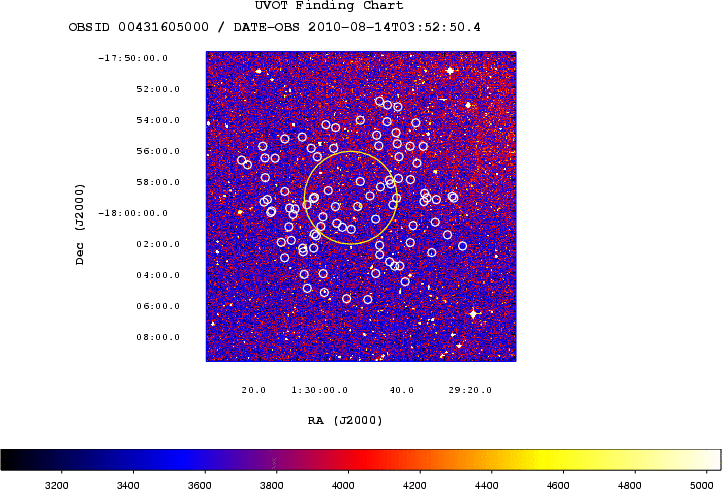
TITLE: GCN/SWIFT NOTICE
NOTICE_DATE: Sat 14 Aug 10 04:01:41 UT
NOTICE_TYPE: Swift-UVOT Image
TRIGGER_NUM: 431605, Seg_Num: 0
POINT_RA: 22.459d {+01h 29m 50s} (J2000)
POINT_DEC: -17.994d {-17d 59' 38"} (J2000)
ROLL: 84.368d
IMG_START_DATE: 15422 TJD; 226 DOY; 10/08/14
IMG_START_TIME: 13964.35 SOD {03:52:44.35} UT, 153.1 [sec] since BAT Trigger Time
FILTER: 7, U
EXPOSURE_ID: 303450770
X_OFFSET: 866 [pixels]
Y_OFFSET: 855 [pixels]
WIDTH: 160 [pixels]
HEIGHT: 160 [pixels]
X_GRB_POS: 1026
Y_GRB_POS: 1015
BINNING_INDEX: 1
IM_URL: sw00431605000msuni0160.fits
SUN_POSTN: 143.66d {+09h 34m 39s} +14.41d {+14d 24' 25"}
SUN_DIST: 123.52 [deg] Sun_angle= 8.1 [hr] (West of Sun)
MOON_POSTN: 194.48d {+12h 57m 55s} -11.75d {-11d 44' 59"}
MOON_DIST: 149.25 [deg]
MOON_ILLUM: 23 [%]
GAL_COORDS: 169.02,-77.28 [deg] galactic lon,lat of the pointing direction
ECL_COORDS: 13.47,-25.34 [deg] ecliptic lon,lat of the pointing direction
COMMENTS: SWIFT-UVOT Image.
COMMENTS: The GRB Position came from the XRT Position Command.
COMMENTS: The image has 2x2 binning (compression).
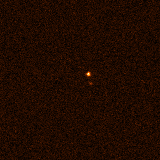
TITLE: GCN/SWIFT NOTICE
NOTICE_DATE: Sat 14 Aug 10 04:02:07 UT
NOTICE_TYPE: Swift-UVOT Processed Image
TRIGGER_NUM: 431605, Seg_Num: 0
POINT_RA: 22.459d {+01h 29m 50s} (J2000)
POINT_DEC: -17.994d {-17d 59' 38"} (J2000)
ROLL: 84.368d
IMG_START_DATE: 15422 TJD; 226 DOY; 10/08/14
IMG_START_TIME: 13964.35 SOD {03:52:44.35} UT, 153.1 [sec] since BAT Trigger Time
FILTER: 7, U
EXPOSURE_ID: 303450770
X_OFFSET: 866 [pixels]
Y_OFFSET: 855 [pixels]
WIDTH: 160 [pixels]
HEIGHT: 160 [pixels]
X_GRB_POS: 1026
Y_GRB_POS: 1015
BINNING_INDEX: 1
IM_URL: sw00431605000msuni0160.fits
SUN_POSTN: 143.66d {+09h 34m 39s} +14.41d {+14d 24' 25"}
SUN_DIST: 123.52 [deg] Sun_angle= 8.1 [hr] (West of Sun)
MOON_POSTN: 194.48d {+12h 57m 56s} -11.75d {-11d 45' 05"}
MOON_DIST: 149.25 [deg]
MOON_ILLUM: 23 [%]
GAL_COORDS: 169.02,-77.28 [deg] galactic lon,lat of the pointing direction
ECL_COORDS: 13.47,-25.34 [deg] ecliptic lon,lat of the pointing direction
COMMENTS: SWIFT-UVOT Processed Image.
COMMENTS: The GRB Position came from the XRT Position Command.
COMMENTS: The image has 2x2 binning (compression).
COMMENTS: All 4 attachments are included.
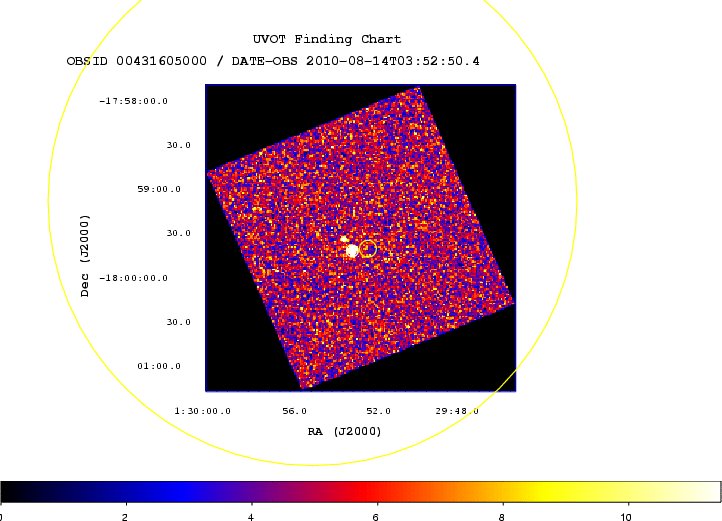
start UT mag mlim(of image) ---------------------------------- 03:55:11.3 17.4 8.0A jpeg image is available at http://www.rotse.net/images/gsq431605_3c011-020_key.jpg Note that the object marked 29 is the candidate in question.
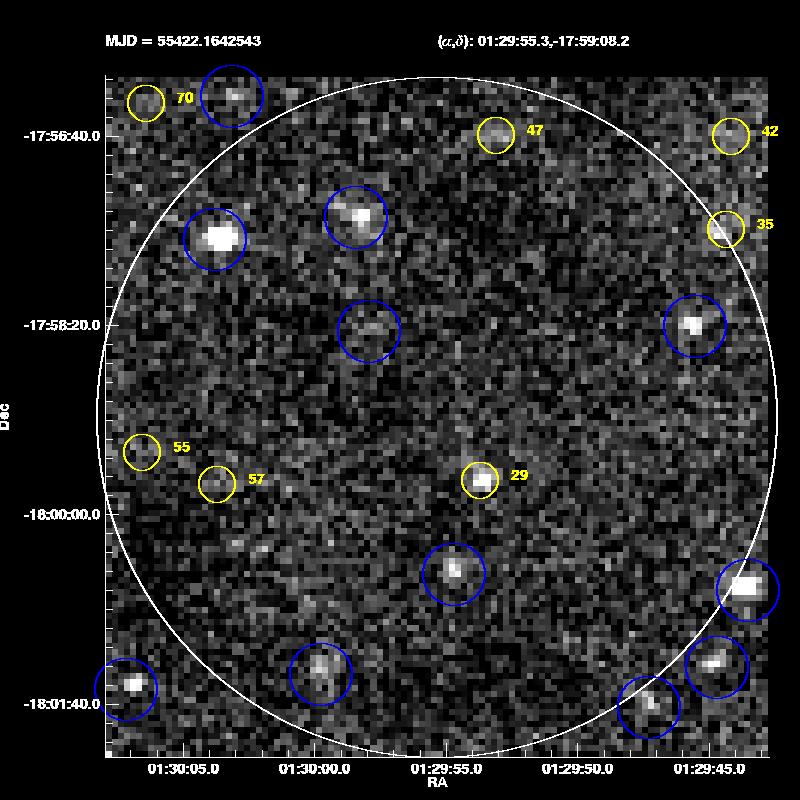
TITLE: GCN/SWIFT NOTICE
NOTICE_DATE: Sat 14 Aug 10 04:17:52 UT
NOTICE_TYPE: Swift-XRT Position UPDATE
TRIGGER_NUM: 431605, Seg_Num: 0
GRB_RA: 22.4724d {+01h 29m 53.37s} (J2000),
22.6011d {+01h 30m 24.25s} (current),
21.8663d {+01h 27m 27.90s} (1950)
GRB_DEC: -17.9963d {-17d 59' 46.6"} (J2000),
-17.9417d {-17d 56' 30.1"} (current),
-18.2541d {-18d 15' 14.8"} (1950)
GRB_ERROR: 3.8 [arcsec radius, statistical plus systematic, 90% containment]
GRB_INTEN: 1.00e-10 [erg/cm2/sec]
GRB_SIGNIF: 10.00 [sigma]
IMG_START_DATE: 15422 TJD; 226 DOY; 10/08/14
IMG_START_TIME: 14258.00 SOD {03:57:38.00} UT, 446.7 [sec] since BAT Trigger Time
TAM[0-3]: 100.00 100.00 100.00 100.00
AMPLIFIER: 1
WAVEFORM: 31
SUN_POSTN: 143.67d {+09h 34m 41s} +14.40d {+14d 24' 13"}
SUN_DIST: 123.52 [deg] Sun_angle= 8.1 [hr] (West of Sun)
MOON_POSTN: 194.63d {+12h 58m 32s} -11.81d {-11d 48' 41"}
MOON_DIST: 149.22 [deg]
MOON_ILLUM: 23 [%]
GAL_COORDS: 169.07,-77.28 [deg] galactic lon,lat of the burst
ECL_COORDS: 13.48,-25.35 [deg] ecliptic lon,lat of the burst
COMMENTS: SWIFT-XRT Coordinates.
COMMENTS: This Notice was ground-generated -- not flight-generated.
COMMENTS: This is an Update Notice -- the RA,Dec values herein supersede the previous XRT_POS Notice.
COMMENTS: TAM values, flux and significance fields are not valid.
COMMENTS: This position was automatically generated on the ground using
COMMENTS: Photon Counting data telemetered via TDRSS (SPER data).
COMMENTS: See http://www.swift.ac.uk/sper/docs.php for details.
COMMENTS: The probability that this is a serendipitous source in the
COMMENTS: SPER window is 0.58% < P(seren) < 1.1%.
RA(J2000) = 01h 29m 55s Dec(J2000) = -17d 59' 07"with an uncertainty of 3 arcmin (radius, 90% containment, including systematic uncertainty). The BAT light curve showed three separate peaks over a total interval of at least 150 sec. The peak count rate was ~6000 counts/sec (15-350 keV), at ~6 sec after the trigger.
RA(J2000) = 01h 29m 53.33s Dec(J2000) = -17d 59' 47.1"with an uncertainty of 3.8 arcseconds (radius, 90% containment). This location is 48 arcseconds from the BAT onboard position, within the BAT error circle. This position may be improved as more data are received; the latest position is available at http://www.swift.ac.uk/sper.
RA = 01h 29m 53.98s Dec=-17d 59m 35.5s(J2000). The estimated magnitude is U=16.8 .
TITLE: GCN/SWIFT NOTICE
NOTICE_DATE: Sat 14 Aug 10 04:57:16 UT
NOTICE_TYPE: Swift-UVOT Source List
TRIGGER_NUM: 431605, Seg_Num: 0
POINT_RA: 22.468d {+01h 29m 52s} (J2000)
POINT_DEC: -17.989d {-17d 59' 19"} (J2000)
POINT_ROLL: 84.376d
IMG_START_DATE: 15422 TJD; 226 DOY; 10/08/14
IMG_START_TIME: 17668.97 SOD {04:54:28.97} UT, 3857.7 [sec] since BAT Trigger Time
FILTER: 10, White
BKG_MEAN: 2.045
N_STARS: 11
X_OFFSET: 523 [pixels]
Y_OFFSET: 599 [pixels]
X_MAX: 1482 [pixels]
Y_MAX: 1558 [pixels]
DET_THRESH: 12
PHOTO_THRESH: 6
SL_URL: sw00431605000msufc3857.fits
SUN_POSTN: 143.70d {+09h 34m 48s} +14.40d {+14d 23' 42"}
SUN_DIST: 123.54 [deg] Sun_angle= 8.1 [hr] (West of Sun)
MOON_POSTN: 195.01d {+13h 00m 01s} -11.96d {-11d 57' 39"}
MOON_DIST: 149.18 [deg]
MOON_ILLUM: 23 [%]
GAL_COORDS: 169.04,-77.27 [deg] galactic lon,lat of the pointing direction
ECL_COORDS: 13.48,-25.34 [deg] ecliptic lon,lat of the pointing direction
COMMENTS: SWIFT-UVOT Source List.
TITLE: GCN/SWIFT NOTICE
NOTICE_DATE: Sat 14 Aug 10 04:57:16 UT
NOTICE_TYPE: Swift-UVOT Source List
TRIGGER_NUM: 431605, Seg_Num: 0
POINT_RA: 22.468d {+01h 29m 52s} (J2000)
POINT_DEC: -17.989d {-17d 59' 19"} (J2000)
POINT_ROLL: 84.376d
IMG_START_DATE: 15422 TJD; 226 DOY; 10/08/14
IMG_START_TIME: 17668.97 SOD {04:54:28.97} UT, 3857.7 [sec] since BAT Trigger Time
FILTER: 10, White
BKG_MEAN: 2.045
N_STARS: 11
X_OFFSET: 523 [pixels]
Y_OFFSET: 599 [pixels]
X_MAX: 1482 [pixels]
Y_MAX: 1558 [pixels]
DET_THRESH: 12
PHOTO_THRESH: 6
SL_URL: sw00431605000msufc3857.fits
SUN_POSTN: 143.70d {+09h 34m 48s} +14.40d {+14d 23' 42"}
SUN_DIST: 123.54 [deg] Sun_angle= 8.1 [hr] (West of Sun)
MOON_POSTN: 195.01d {+13h 00m 01s} -11.96d {-11d 57' 39"}
MOON_DIST: 149.18 [deg]
MOON_ILLUM: 23 [%]
GAL_COORDS: 169.04,-77.27 [deg] galactic lon,lat of the pointing direction
ECL_COORDS: 13.48,-25.34 [deg] ecliptic lon,lat of the pointing direction
COMMENTS: SWIFT-UVOT Source List.
TITLE: GCN/SWIFT NOTICE
NOTICE_DATE: Sat 14 Aug 10 04:57:42 UT
NOTICE_TYPE: Swift-UVOT Processed Source List
TRIGGER_NUM: 431605, Seg_Num: 0
POINT_RA: 22.468d {+01h 29m 52s} (J2000)
POINT_DEC: -17.989d {-17d 59' 19"} (J2000)
POINT_ROLL: 84.376d
IMG_START_DATE: 15422 TJD; 226 DOY; 10/08/14
IMG_START_TIME: 17668.97 SOD {04:54:28.97} UT, 3857.7 [sec] since BAT Trigger Time
FILTER: 10, White
BKG_MEAN: 2.045
N_STARS: 11
X_OFFSET: 523 [pixels]
Y_OFFSET: 599 [pixels]
X_MAX: 1482 [pixels]
Y_MAX: 1558 [pixels]
DET_THRESH: 12
PHOTO_THRESH: 6
SL_URL: sw00431605000msufc3857.fits
SUN_POSTN: 143.70d {+09h 34m 48s} +14.39d {+14d 23' 42"}
SUN_DIST: 123.54 [deg] Sun_angle= 8.1 [hr] (West of Sun)
MOON_POSTN: 195.01d {+13h 00m 02s} -11.96d {-11d 57' 45"}
MOON_DIST: 149.18 [deg]
MOON_ILLUM: 23 [%]
GAL_COORDS: 169.04,-77.27 [deg] galactic lon,lat of the pointing direction
ECL_COORDS: 13.48,-25.34 [deg] ecliptic lon,lat of the pointing direction
COMMENTS: SWIFT-UVOT Processed Source List.
COMMENTS: All 4 attachments are included.
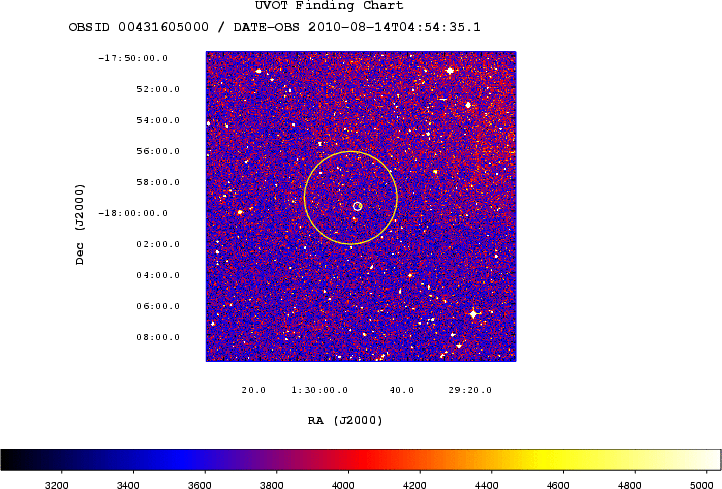
TITLE: GCN/SWIFT NOTICE
NOTICE_DATE: Sat 14 Aug 10 04:58:40 UT
NOTICE_TYPE: Swift-UVOT Image
TRIGGER_NUM: 431605, Seg_Num: 0
POINT_RA: 22.468d {+01h 29m 52s} (J2000)
POINT_DEC: -17.989d {-17d 59' 19"} (J2000)
ROLL: 84.376d
IMG_START_DATE: 15422 TJD; 226 DOY; 10/08/14
IMG_START_TIME: 17668.97 SOD {04:54:28.97} UT, 3857.7 [sec] since BAT Trigger Time
FILTER: 10, White
EXPOSURE_ID: 303454475
X_OFFSET: 842 [pixels]
Y_OFFSET: 918 [pixels]
WIDTH: 160 [pixels]
HEIGHT: 160 [pixels]
X_GRB_POS: 1002
Y_GRB_POS: 1078
BINNING_INDEX: 1
IM_URL: sw00431605000msuni3864.fits
SUN_POSTN: 143.70d {+09h 34m 48s} +14.39d {+14d 23' 41"}
SUN_DIST: 123.55 [deg] Sun_angle= 8.1 [hr] (West of Sun)
MOON_POSTN: 195.02d {+13h 00m 04s} -11.97d {-11d 57' 58"}
MOON_DIST: 149.18 [deg]
MOON_ILLUM: 23 [%]
GAL_COORDS: 169.04,-77.27 [deg] galactic lon,lat of the pointing direction
ECL_COORDS: 13.48,-25.34 [deg] ecliptic lon,lat of the pointing direction
COMMENTS: SWIFT-UVOT Image.
COMMENTS: The GRB Position came from the Window Position in the Mode Command.
COMMENTS: The image has 2x2 binning (compression).
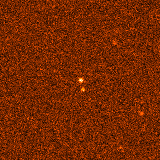
TITLE: GCN/SWIFT NOTICE
NOTICE_DATE: Sat 14 Aug 10 04:58:59 UT
NOTICE_TYPE: Swift-UVOT Processed Image
TRIGGER_NUM: 431605, Seg_Num: 0
POINT_RA: 22.468d {+01h 29m 52s} (J2000)
POINT_DEC: -17.989d {-17d 59' 19"} (J2000)
ROLL: 84.376d
IMG_START_DATE: 15422 TJD; 226 DOY; 10/08/14
IMG_START_TIME: 17668.97 SOD {04:54:28.97} UT, 3857.7 [sec] since BAT Trigger Time
FILTER: 10, White
EXPOSURE_ID: 303454475
X_OFFSET: 842 [pixels]
Y_OFFSET: 918 [pixels]
WIDTH: 160 [pixels]
HEIGHT: 160 [pixels]
X_GRB_POS: 1002
Y_GRB_POS: 1078
BINNING_INDEX: 1
IM_URL: sw00431605000msuni3864.fits
SUN_POSTN: 143.70d {+09h 34m 48s} +14.39d {+14d 23' 41"}
SUN_DIST: 123.55 [deg] Sun_angle= 8.1 [hr] (West of Sun)
MOON_POSTN: 195.02d {+13h 00m 05s} -11.97d {-11d 58' 03"}
MOON_DIST: 149.18 [deg]
MOON_ILLUM: 23 [%]
GAL_COORDS: 169.04,-77.27 [deg] galactic lon,lat of the pointing direction
ECL_COORDS: 13.48,-25.34 [deg] ecliptic lon,lat of the pointing direction
COMMENTS: SWIFT-UVOT Processed Image.
COMMENTS: The GRB Position came from the Window Position in the Mode Command.
COMMENTS: The image has 2x2 binning (compression).
COMMENTS: All 4 attachments are included.
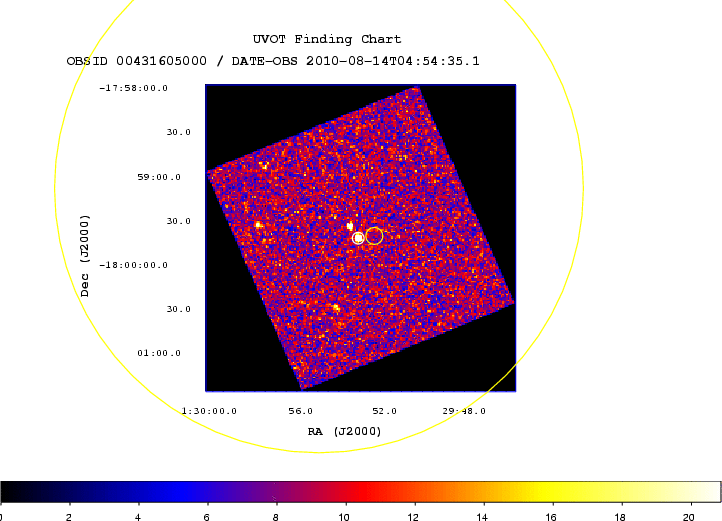
RA (J2000): 01h 29m 53.54s Dec (J2000): -17d 59' 42.1"with an uncertainty of 1.5 arcsec (radius, 90% confidence).
RA(J2000) = 01h 29m 55.0s Dec(J2000) = -17d 59' 25.7"with an uncertainty of 1.0 arcmin, (radius, sys+stat, 90% containment). The partial coding was 90%.
ÃRA Ã(J2000) = 01h 29m 53.61s = 22.47338 ÃDec (J2000) = -17d 59m 43.6s = -17.99545with an estimated uncertainty of 0.6 arcsec (radius, 90% confidence, statistical + systematic). This is about 1.5 arcsec north of the UVOT-enhanced XRT position (Beardmore et al. 2010, GCN Circ. 11092).
Filter    T_start  T_stop   Exp(s)    Mag  Err ---------------------------------------------------------------------   u (fc)    153    403    246   16.80 0.06   v      458    627     39    17.91 0.32   b      408    721     53    21.22 0.20   u      153    701    285    16.84 0.06  uvw1     507    676     39    17.33 0.20  uvm2    483   651    39    17.86 0.31  uvw2     434   602    39   >18.52  3-sigma UL  white    3858   4211    344    18.63 0.07 ----------------------------------------------------------- The quoted magnitudes and upper limits have not been corrected for the expected Galactic extinction along the line of sight corresponding to a reddening of E_{B-V} = 0.02 mag (Schlegel, et al., 1998, ApJS, 500, 525).  All photometry is on the UVOT photometry system described in Poole et al. (2008, MNRAS, 383, 627).
Filter T_start T_stop Exp(s) Mag Err
----------------------------------------------------------
u (fc) 153 403 246 16.80 0.06
v 458 627 39 17.91 0.32
b 408 721 53 21.22 0.20
u 153 701 285 16.84 0.06
uvw1 507 676 39 17.33 0.20
uvm2 483 651 39 17.86 0.31
uvw2 434 602 39 >18.52 3-sigma UL
white 3858 4211 344 18.63 0.07
----------------------------------------------------------
====================================== Filter T-To (days) Mag -------------------------------------- R 2.96 19.75 +/- 0.02 I 2.93 18.32 +/- 0.04 ======================================The photometric calibration is performed against USNO-B1 objects 0720-0016107 (R2=19.58) and 0719-0016667 (I=17.27). Our detection is consistent with the values reported by Malesani et al. (GCN 11121). Observations are ongoing.
T-T0, filter, exposure, OT (day) 3.2689 W 300x7 19.79 +/- 0.05the photometry error is statistical only.=20
T-T0, filter, exposure, OT (day) 6.2205 W 300x10 21.66 +/- 0.23 7.2734 W 300x15 22.50 +/- 0.30The photometry errors are statistical only.
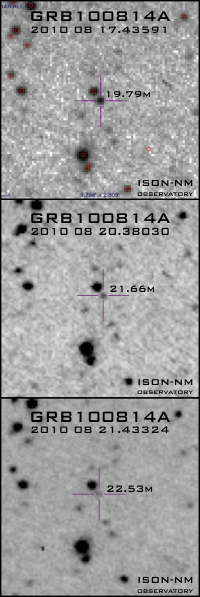
t-T0, Filter, Exposure, OT, Upper limit (3 sigma) (mid, d) (s) 0.81185 R 30*60 18.75+/-0.01 23.4the photometry error is statistical only.